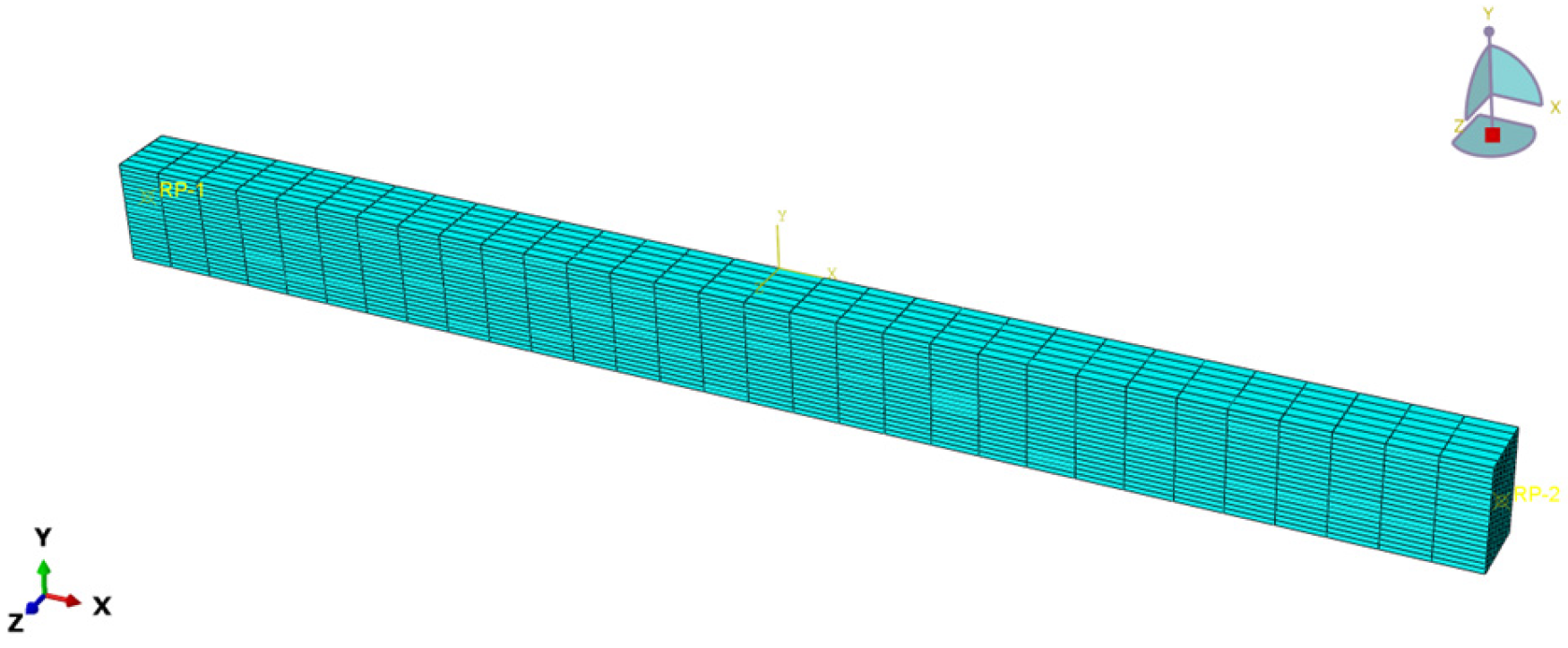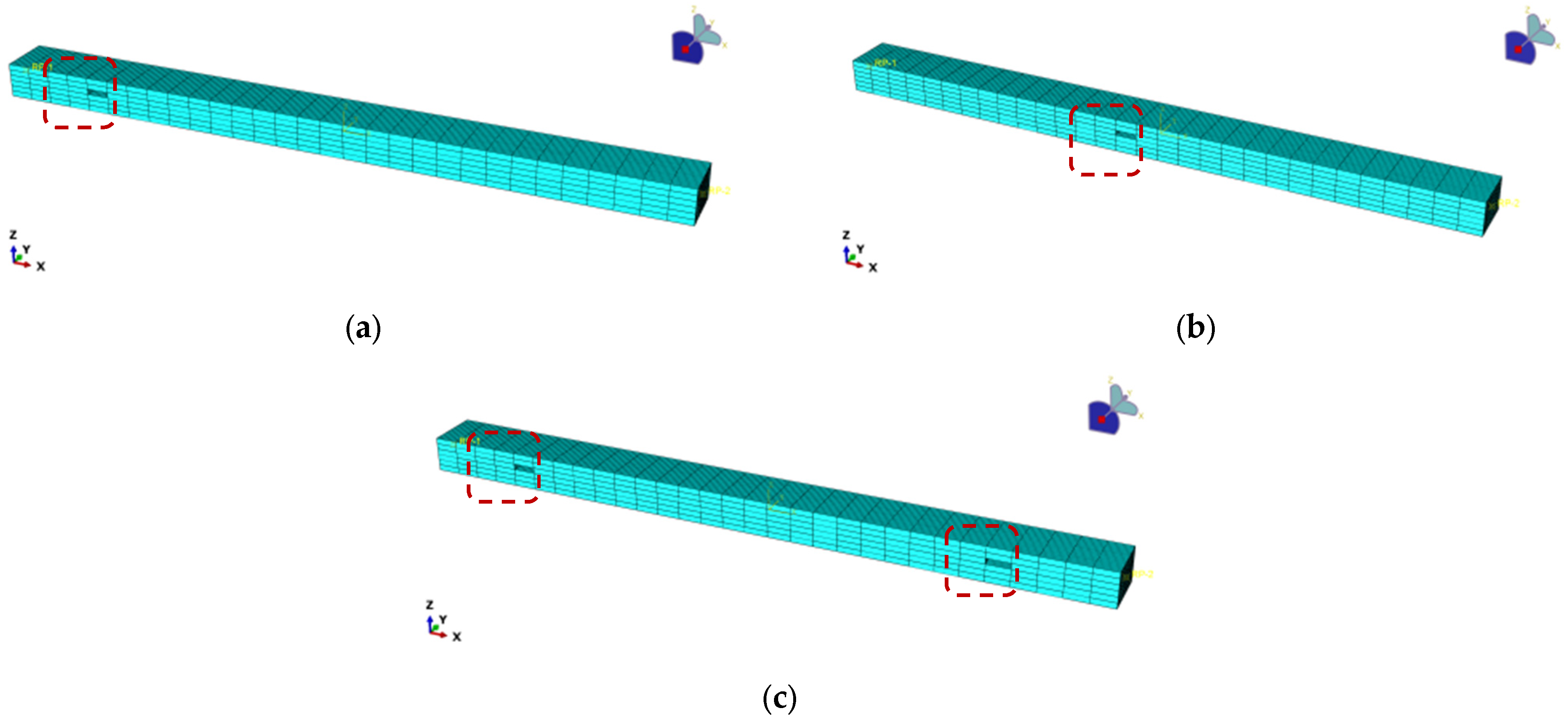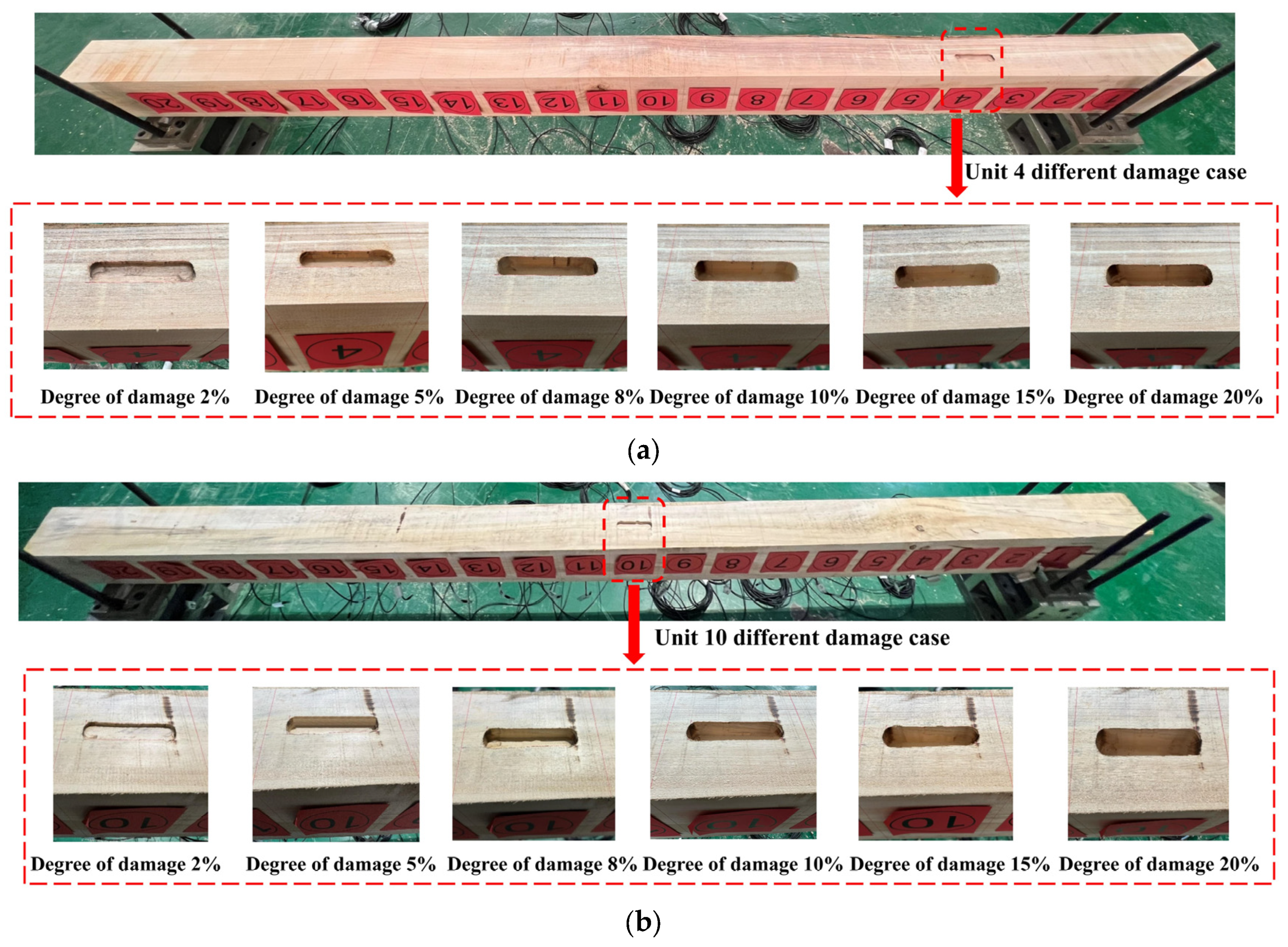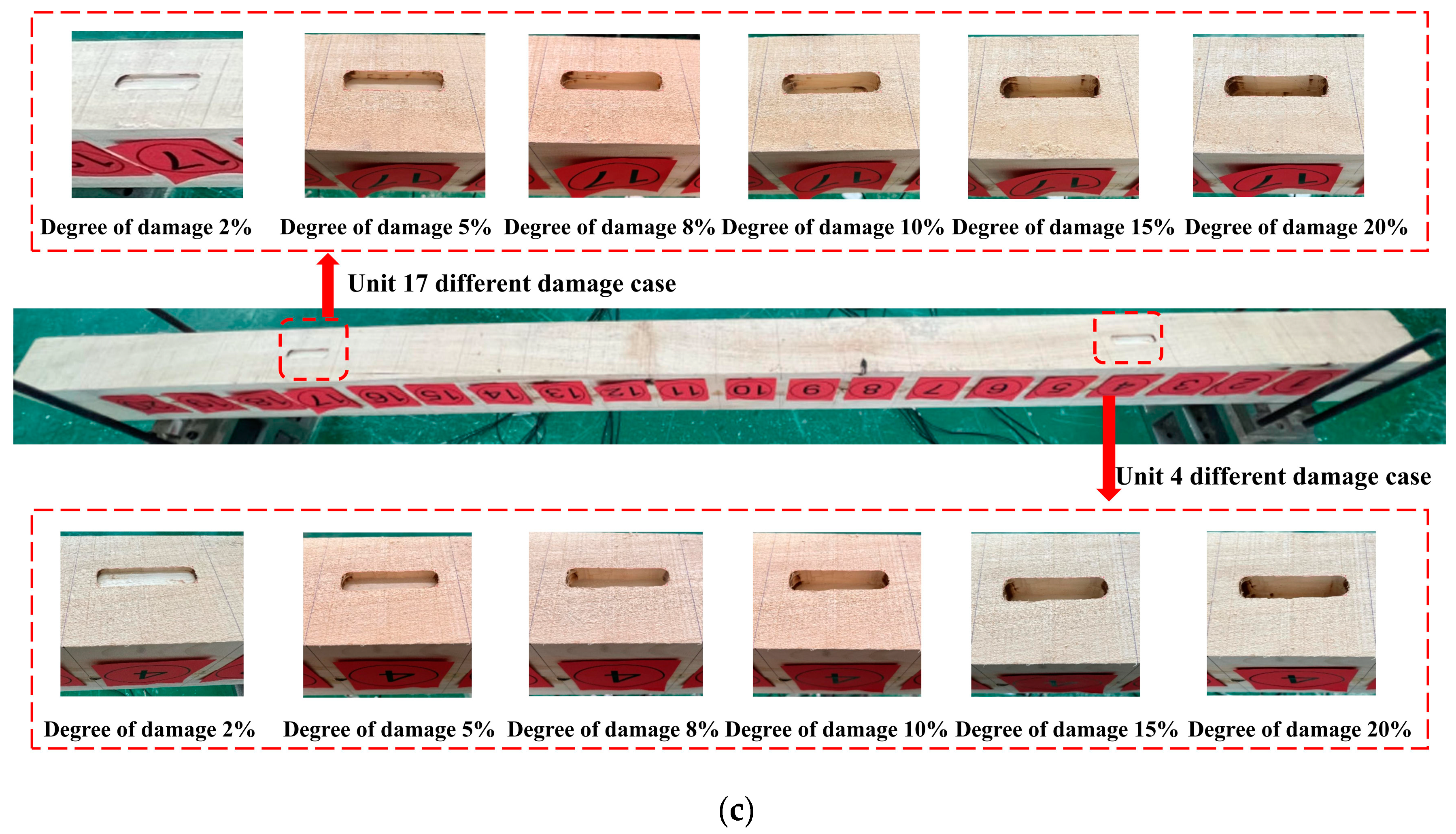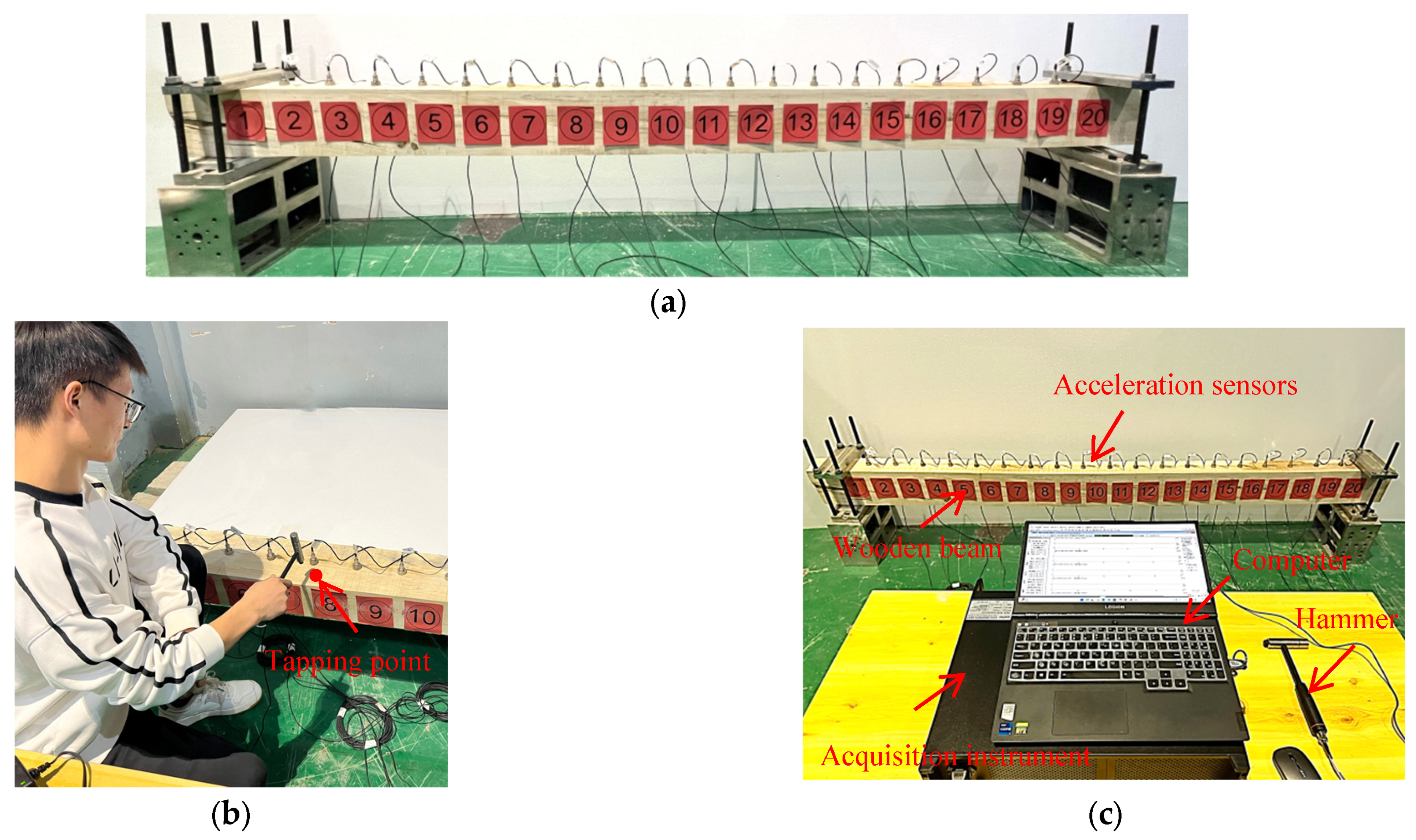1. Introduction
A large portion of China’s historical and cultural legacy consists of the timber structures of ancient buildings [
1,
2]. However, due to factors like the external climate and the material itself, wood components will unavoidably experience varying degrees of deterioration throughout the course of their extended service [
3,
4,
5]. This will affect the safe use of the wooden building and lower its overall safety, applicability, and durability. The preservation of historic buildings’ wooden structures depends on carrying out damage identification research on their wooden components.
Researchers have been studying damage identification more and more in recent years [
6,
7,
8]. Damage identification is an essential part of keeping historic buildings’ timber structures healthy. Among several damage assessment methods, vibration-based methods are preferred as damage detection tools instead of static measurement methods [
9,
10] because of their flexible evaluation techniques, information accessibility, and cost [
11]. It is being used more and more.
The underlying idea is that physical parameters are altered due to damage to the structure, and these changes, in turn, affect the modal aspects of the structure, including its natural frequencies and vibration mode. Therefore, the changes in these modal characteristics can be utilized as an important indicator to determine the presence of structural damage [
12].
Among the different damage detection indicators employed in structural modal parameter testing, the natural frequencies are the most straightforward to measure and have the best accuracy [
13,
14]. However, natural frequencies are an international variable that does not allow for the accurate localization of structural damage [
15]. The value of its variation is significantly smaller when the building is subjected to slight damage. It is difficult to determine the precise site of structural damage since it fluctuates based on environmental parameters, such as temperature and humidity [
16]. Other related metrics, such as curvature modes, strain modes, and strain mode curvature differences, can be created based on the differentiation of the forms. The mode shapes carry more spatial and damage location information than the natural frequencies. Pandey et al. [
17] were the first to propose the use of the central difference of displacement modes to produce curvature modes, which could subsequently be used to diagnose damage to buildings. He et al. [
18] demonstrated how the curvature mode difference index, when combined with finite element simulation and testing, can be used to determine the location and degree of structural damage in cantilever beams. Xiang et al. [
19] proposed an information entropy based on curvature modal utility as a damage identification indicator; tests and numerical simulations on supported beams are utilized to verify the validity of the index.
By simulating and analyzing reinforced concrete beams, Dawari and Vemawala [
20] provided a damage identification approach based on modal curvature and modal flexibility differences; the findings showed that the recommended method successfully locates honeycomb damage in beams. When strain proportional to curvature was combined with measured strain data for modal analysis, as performed by Yao et al. [
21], the damage diagnosis that resulted was more precise than when using the curvature modes approach. The results showed the exceptional robustness and accuracy of the presented method for localizing cable-stayed bridge girders. Xu et al. [
22] used the distributed strain modal method to identify the damage of large-span, cable-stayed bridges and established the damage identification index of the residual trend of the distributed strain modal using statistical trend analysis and confidence probability. Wang et al. [
23] employed work modal analysis and strain modal studies to pinpoint the damage on a four-span bridge model. Cui et al. [
24] used an eigensystem approach in combination with the strain modal damage detection method to investigate the damage of cantilever girders under natural excitation. The experiments showed that the approach could more accurately identify the damaged section of the rafters.
Li et al. [
25,
26] and Chan et al. [
27] employed measured stresses for their fatigue investigation and life prediction of natural suspension bridges. Zhang et al. [
28] employed the strain mode curvature difference and the first-order strain mode vibration pattern as damage identification indices to find structural damage in track slabs, such as cracks and dehollowing. The outcomes proved how successful the chosen damage identification indices were. Li et al. [
29] promoted the use of strain modal difference as a tool for identifying and detecting damage to cantilever beam structures, and they presented experimental evidence supporting the method’s effectiveness in detecting structural damage. Zhang et al. [
30] were able to locate the damage to the structure by building a finite element model of a three-span continuous bridge and using the variation in strain mode differential vibration patterns at the damage site. To sum up, the strain modes and the indices that are derived from them have the following advantages: they are more sensitive to local structural changes and have a more accurate influence on the location of the structural damage. Compared to displacement vibration mode and curvature mode, the strain modes have two advantages: (1) they are also derived from differentiation, which amplifies the displacement of the damaged portion of the structure, increasing its identification effect and sensitivity to changes in structural damage; and (2) they are more effective than the other modal parameters at differentiating between the damage of smaller and complex structures.
As science and technology have developed, deep learning (DL) and artificial intelligence (AI) algorithms have been used extensively in recent years to evaluate and predict the onset and spread of structural damage, which has a large potential for application in engineering challenges [
31,
32,
33,
34,
35,
36]. The systematic summary by Avci et al. [
37] of the application of deep-learning and machine-learning techniques as well as traditional methods in vibration-based structural damage detection shows that these techniques have produced notable improvements in structural damage detection and have the potential to increase detection efficiency and accuracy. A novel damage detection technique was presented by Nguyen et al. [
38]. To precisely determine the position and degree of damage to beam structures as well as the overall stiffness change in the structure, they employed Bayesian deep learning and balancing composite motion optimization.
The cross-section of thin beams with heights significantly less than spans in genuine engineering constructions is assumed to be free of strain both before and after deformation and perpendicular to the central axis. The theory that explains the deformation and force characteristics of such beams is called classical beam theory, or Eulerian–Bernoulli beam theory [
39]. A number of recent studies have been conducted in light of the sophisticated theories previously discussed, elucidating the impact of damage on the vibration properties of beams and bars [
40,
41,
42,
43]. We find that the theory more accurately characterizes and predicts the dynamic behavior of structures when damage effects are taken into account. These results are critical to the development of new preventative strategies as well as a deeper comprehension of the diversity of structural vibration characteristics. This research focuses on the problem of damage detection of Eulerian–Bernoulli beams whose spans are significantly larger than their heights, building on the earlier work.
In light of this, this article proposes a method for identifying damage in simply supported wooden timbers by utilizing the curvature difference between strain modes. In contrast to alternative modal parameters, the strain modal curvature difference index exhibits a substantial precipitous change at the damaged location while displaying virtually no abrupt change at the undamaged location. This characteristic contributes to the enhanced accuracy of damage identification. Specifically, numerical simulation and damage identification tests are used to obtain the modal parameters of the beam under various damage conditions; then, the damage identification indexes based on strain mode, strain mode difference, and strain mode curvature difference are applied to the test data and the numerical simulation data, respectively, to determine the damage localization. In order to ascertain the damage localization identification indices that are most sensitive to the local damage of wooden beams, the results of damage localization identification using experimental data and numerical simulation data are contrasted.

